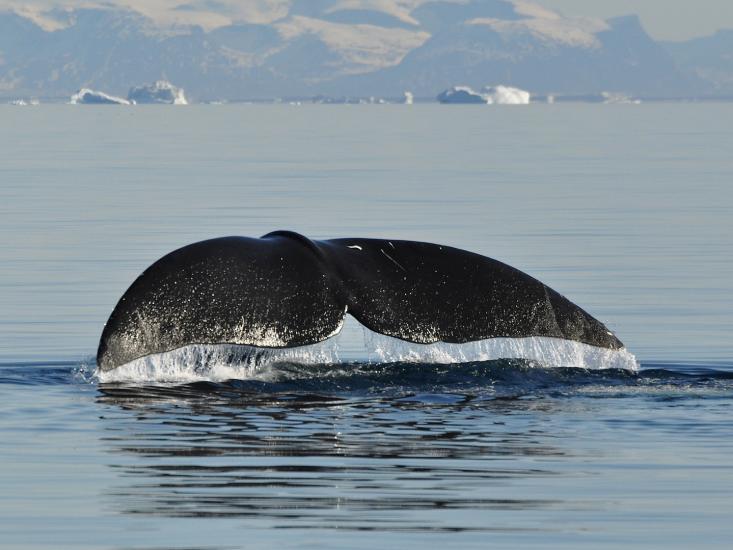
The Arctic they grew up in is unrecognizable, but bowhead whales are oddly calm. They appear to be unexpectedly benefitting from the warmer, less icy climate that has emerged over the past decade. Last month, it was announced that the Arctic in 2015 reached the warmest temperatures ever observed, and that it is warming twice as fast other parts of the world. It’s also losing ice at a faster rate than forecasts have predicted—and is expected to be ice-free by at most summer 2040.
This means changes underwater, too. More sunlight hitting surface water and changes in ocean circulation, fueled by warmer waters and the stronger storms associated with them, are boosting the numbers of krill and other planktons in some Arctic seas. Sue Moore, a NOAA biologist, calls this a “new normal” in the Arctic. And bowhead whales, at least in the Pacific Arctic of Alaska and northwestern Canada, where the most and best data is available, appear to be just fine with that.
How are these massive whales—which populate the Arctic year-round and regularly live for more than a century—coping in an ecosystem different than the one they grew up in? Solving the mystery could shed light on who will and won’t inherit the changing Arctic. It could also have implications for the world economy, as increasing Arctic ship traffic may be on a literal collision course with increased whale numbers.
“At least for now,” says Moore, “it’s a very good time to be a bowhead whale. In terms of resiliency, bowheads could be near the top because they’re already built to survive in tough conditions.” They have one of the lowest core body temperatures and the ability to survive long periods of near fasting while relying on massive energy stores. “If the ice goes away,” she says, “it’s not doomsday [for them].” She also noted that a study from earlier this year found bowhead body condition—at least off of Alaska and surrounding regions—to be actually better today, in the new low-ice normal, and that their numbers are increasing.
Recent studies are beginning to confirm that. Dan Pendleton, a research scientist at the New England Aquarium, has been looking at how the bowhead habitat north of Alaska and northwestern Canada has changed over the past quarter-century in order to predict habitat changes in coming decades. He says we are likely to see habitats generally become more suitable for bowheads both earlier and later in the year in the Beaufort Sea, due to increases in the availability of krill and copepods, a group of microscopic crustacean.
But bowheads may not be as fortunate elsewhere.
In the waters of northeastern Canada and western Greenland, where cool Arctic and warmer Atlantic waters intermix, whales rely heavily on copepods as a food source. If we continue to see warmer waters, says Sarah Fortune, a doctoral student studying bowheads at the University of British Columbia, the smaller, faster-growing Atlantic copepods will out-compete the heftier Arctic copepods, which are three times larger and thus far more nourishing and beneficial for a gigantic whale. “Bowheads could have lower quality prey if trends continue,” she says.
But she notes that we don’t yet know for certain how that could affect the whales. Atlantic copepods could, perhaps, do so well that there’s so many of them around that the loss of the larger Arctic ones won’t matter—quantity could negate the loss of quality. There are a lot of unknowns when an ice-adapted world suddenly loses its ice.
But some generalizations about who will be able to take the heat are emerging. Needing—versus simply being able to live with—ice, and adaptability to changes in prey species and availability, could be the main drivers of who makes it and who doesn’t in the New Arctic.
A number of studies presented at the Society of Marine Mammalogy biennial conference earlier this month noted the plight of walruses and polar bears, for instance. With less sea ice to rest on, walruses are having to congregate on land, which means they have to swim much farther to hunt. So far, studies are showing no increase in stress hormones in walruses, but other studies are showing they’re using up more energy more quickly and that their body conditions and numbers are declining. Even if there happens to be more food for the walruses, it’s getting harder for them to get it; they could be the anti-bowhead.
“We don’t often think of walruses as being at risk of going extinct. But they all have a common ancestor. They almost went extinct 125,000 years ago,” Beth Shapiro, an evolutionary biologist at UC-Santa Cruz told the conference. If the future is going to be hotter than it was then, she said, it’ll be “bad news for walruses.”
But there’s one animal whose presence in the Arctic is already rapidly expanding: humans. A whale very similar to bowheads, right whales—which look and feed so much like bowheads that whalers often confused the two species—has struggled to bounce back from whaling as bowheads have. The assumption is that entanglement in fishing gear and other human impacts on right whales is to blame.
Bowheads appear to be okay with the stressors of changing temperatures and prey and ocean conditions so far, but they haven’t had to constantly deal with humans—which could be a persistent presence and nuisance—until now.
Matthew Berger is a writer based in Portland, reporting for the Guardian, Discover, Agence France-Presse and Upworthy. He previously wrote about salmon domestication in Nautilus’s Issue 030. You can follow him at @matthewoberger.






























